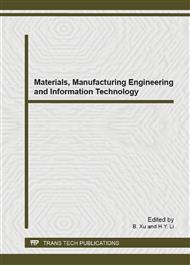[1]
GOODMAN R E. Subaudible noise during com pression of rock [J]. Geological Society of America Bulle tin, 1963, 74 (4): 4 87-4 90.
Google Scholar
[2]
Zhao Zhizhong, Ding Yuanchen, Qian Fang, et al. A New Method for Identifying Moraine[J]. ACTA GEOSCIENTIA SINICA, 2000, 21 (4): 396–400.
Google Scholar
[3]
Sun Baoshan, Ding Yuanchen, Shao Zhaogang, et al. APPLICATION OF ACOUSTIC EMISSION TECHNIQUE IN DETERMINATION OF FOSSIL AND PRESENT-DAY STRESSES IN OIL FIELDS [J]. JOURNAL OF GEOMECHANICS, 1996, 2 (2): 11–17.
Google Scholar
[4]
KANAGAWA T,HAYASHI M,NAKAS H. Estimation of spatialgeostresses components in rock samples using the Kaiser effect ofacoustic emission. Proceedings of the 3rd Acoustic Emission Symposium, 1976, 229–248.
Google Scholar
[5]
Ding Yuanchen, Zhang Dalun. A NEW METHOD FOR ESTIMATING PRE-EXSTING STRESS IN ROCK BY ACOUSTIC EMISSION [J]. GEOSCIENCE, 1989, 3 (3): 359–368.
Google Scholar
[6]
WANG Xxiaoqiong, GE Hongkui, SONG Lili, et al. EXPERIMENTAL ATUDY OF TWO TYPES OF ROCK SAMPLE ACOUSTIC EMISSION EVENTS AND KAISER EFFECT POINT PECOGNITION APPROACH [J]. Chinese Journal of Rock Mechanics and Engineering. 2011, 3 (30): 580-588.
Google Scholar
[7]
Hardy. H.R. Emergence of acoustic emision/microseismic activity as a tool in geomechanics. In Proceedings of the First Conference on Acoustic Emission/Microseismic Activity in Geologic Structures and Materials, University Park. Edited by H.R. Hardy and L.W. Leighton, Trans Tech Puplications, Clausthal Zellerfeld, 1997, 3-31.
DOI: 10.1016/b978-0-444-87450-4.50112-0
Google Scholar
[8]
Aggelis, D.G., Shiotani, T., Terazawa, M. Assessment of construction joint effect in full-scale concrete beams by acoustic emission activity. J. Eng. Mech, 2010, 136 (7): 906 – 912.
DOI: 10.1061/(asce)em.1943-7889.0000130
Google Scholar
[9]
Carpinteri, A., Cardone, F., Lacidogna, G. Energy emissions from failure phe-nomena: mechanical, electromagnetic, nuclear. Exp. Mech., 2010, 50, 1235-1243.
DOI: 10.1007/s11340-009-9325-7
Google Scholar
[10]
Zhou, J.W., Xu, W.Y., Yang, X.G. A microcrack damage model for brittle rocks under uniaxial compression. Mech. Res. Commun, 2010, 37, 399-405.
DOI: 10.1016/j.mechrescom.2010.05.001
Google Scholar
[11]
Cai, M., Kaiser, P.K. FLAC/PFC coupled numerical simulation of AE in large-scale underground excavations. Int.J. Rock Mech. Min. Sci., 2007, 550-564.
DOI: 10.1016/j.ijrmms.2006.09.013
Google Scholar
[12]
Joseph F. Labuz. Acoustic emission at failure in quasi-brittle materials. Construction and Building Materials, 2001, 15, 225-233.
DOI: 10.1016/s0950-0618(00)00072-6
Google Scholar
[13]
P.G. Ranjith. A study of effect of displacement rate and moisture content on the mechanical properties of concrete: Use of acoustic emission. Mechanics of Materials, 2008, 40, 453 - 469.
DOI: 10.1016/j.mechmat.2007.11.002
Google Scholar


